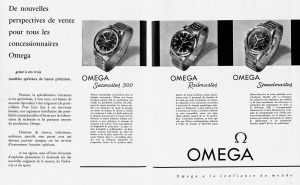Difference between revisions of "Omega Seamaster - The History"
| Line 11: | Line 11: | ||
Omega engineers was so confident of the Seamaster’s durability, they attached one to the outside of an aircraft and flew it over the North Pole in 1956. | Omega engineers was so confident of the Seamaster’s durability, they attached one to the outside of an aircraft and flew it over the North Pole in 1956. | ||
| − | + | [[File:Omega ad.jpg|thumb]] | |
In 1957, when scuba diving was THE sport, Omega rolled out a trio of Master watches: the Speedmaster, the Railmaster and the Seamaster 300. Unlike its predecessor, the Seamaster 300 was designed for underwater use. Ironically, however, the Seamaster 300 could only dive to depths of 200 meters which Omega claimed was due to equipment limitations, not the watch’s limitations. | In 1957, when scuba diving was THE sport, Omega rolled out a trio of Master watches: the Speedmaster, the Railmaster and the Seamaster 300. Unlike its predecessor, the Seamaster 300 was designed for underwater use. Ironically, however, the Seamaster 300 could only dive to depths of 200 meters which Omega claimed was due to equipment limitations, not the watch’s limitations. | ||
Revision as of 02:57, 6 May 2020
Brief History of the Omega Seamaster
The Seamaster is the longest running product line still produced by Omega. It was introduced in 1948, and was loosely based upon designs made for the British Royal Navy towards the end of World War II. The original Seamaster's key feature was an O-ring gasket used to provide its waterproof seal. This design had been developed for use in submarines during the war, and turned out to also be useful for watches, where it made them much less vulnerable to temperature and pressure changes than earlier (lead or shellac) based gasket designs. The Omega Seamaster first made a diving record in 1955, when diver Gordon McLean reached a depth of 62.5 meters (205 ft) in Australia.
The Omega Seamaster’s Original Design
Jumping back a little bit: in 1932, Omega debuted its Marine watch which was worn by the “father of modern diving” Yves Le Prieur, a French navy officer and inventor of the modern scuba mask and tank. Later, in 1936, explorer Charles William Beebe wore the Omega Marine watch while riding in a bathysphere (which was an unpowered sea submersible that was lowered into the ocean via a cable) to a depth of 14 meters off the coast of Bermuda. So by 1948, Omega was a brand well-respected for its robust divers’ watches, and it further bolstered that reputation with the introduction of the Omega Seamaster.
The first Omega Seamaster was modeled after the waterproof wristwatches made for and worn by the British military during World War II. What distinguished the Seamaster from its diving watch predecessors was its O-ring gasket which improved its water-resistance. Previously water-resistant watches relied on lead or shellac gaskets which were easily affected by temperature changes like those a diver would experience at various depths. Omega turned to the submarines used during WWII for inspiration and included a resilient rubber gasket in the Seamaster’s final design. This new case remained intact at depths up to 60 meters and temperature ranges between -40 degrees and 50 degrees Celsius.
Omega engineers was so confident of the Seamaster’s durability, they attached one to the outside of an aircraft and flew it over the North Pole in 1956.
In 1957, when scuba diving was THE sport, Omega rolled out a trio of Master watches: the Speedmaster, the Railmaster and the Seamaster 300. Unlike its predecessor, the Seamaster 300 was designed for underwater use. Ironically, however, the Seamaster 300 could only dive to depths of 200 meters which Omega claimed was due to equipment limitations, not the watch’s limitations.
The 1960s
And continuing the tradition of Omega as the go-to watch for divers, famed oceanographer Jacques Cousteau’s team wore Omega Seamaster 300 watches during their 1963 Conshelf II experiments in the Red Sea. Over the span of three increasingly longer dives, Cousteau aimed to prove man could live and work on the sea floor.
In the hierarchy of Omega dress watches, the Seamasters were somewhere in the middle; above the Geneve but below the Constellation. The Constellation remained the pride of Omega for many years and new technologies were first introduced into that line first. Seamasters and Constellations did share a lot of the same movements but Seamasters were not chronometer tested and were not as elaborately finished. The De Ville started as a sub-brand of the Seamaster but in 1967, it became its own separate brand.

